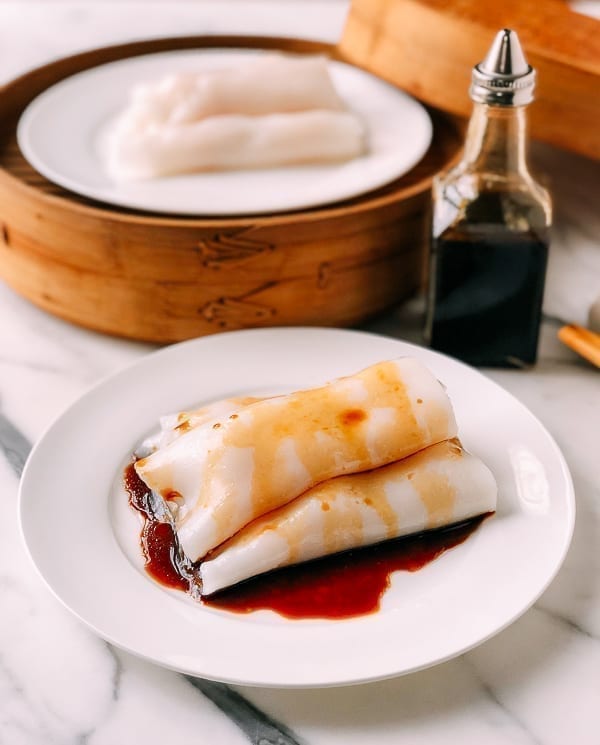Shrimp Rice Noodle Rolls (Shrimp Cheung Fun or “Ha Cheung”)
4.9
(12)
Your folders
Your folders
Prep Time: 165 minutes
Cook Time: 15 minutes
Total: 180 minutes
Servings: 8
Author : Judy

Ingredients
Export 16 ingredients for grocery delivery
Instructions
Step 1
Toss the cleaned shrimp with 2 tablespoons water, 1/2 teaspoon sugar and 1/8 teaspoon baking soda. After the shrimp have been coated, cover and refrigerate for 2 hours.
Step 2
After 2 hours, rinse the shrimp under a gentle stream of cold running water for 5 minutes to wash away the sugar and baking soda and pat thoroughly dry with a paper towel. This will greatly improve the texture of the shrimp!
Step 3
Marinate the shrimp with 1/4 teaspoon sesame oil, a pinch of salt, 1/2 teaspoon cornstarch, and 1/4 teaspoon ground white pepper. Cover and return to the refrigerator while you prepare the rest of the ingredients.
Step 4
Prepare the sauce by adding all the ingredients to a small saucepan over medium low heat. Heat the sauce until it begins to simmer, and turn off the heat. Cool completely and remove the ginger and scallion. You can store this sauce in the refrigerator for up to 2 weeks.
Step 5
Combine the rice flour, mung bean starch, wheat starch, cornstarch, and salt in a large mixing bowl. Add the water and stir for at least three minutes until dry ingredients are well dissolved. Set aside and allow time for any air bubbles to dissipate.
Step 6
Soak the cotton cloth in water so it’s completely saturated. Prepare a large assembly station by brushing some oil on a clean, smooth surface like a non-porous countertop, a large flat plate, or a smooth cutting board.
Step 7
Pre-boil water in your steamer with the lid on (more on how to set up a steamer here), and make sure your steamer fits the flat-bottomed pan you will use to steam the rice noodles. I used a 9 x 13 non-stick sheet pan. This recipe makes 2 full sheets of rice noodles in this sized pan (equivalent to almost 3 dim sum orders).
Step 8
First, place the shrimp in a single layer on a plate, and steam them for 2 minutes. Remove them immediately and set aside.
Step 9
Now lift the soaking wet cotton cloth out of the water and line the bottom of the pan with it. (Do not wring out the water.) Stir the rice-flour liquid mixture well again before adding just enough to cover the cloth at the bottom of the pan completely. Too much will make the rice noodle too thick. With the water in your steamer boiling, use the plate gripper and carefully lower the pan into the steamer, immediately cover the lid and steam on high for 2 minutes. (MAKE SURE THE PAN IS PERFECTLY LEVEL, or the noodle will be too thick on one side and too thin on the other.)
Step 10
Then remove the pan from the steamer with the plate gripper and position it next to your assembly station.
Step 11
Carefully lift the cloth out of the pan, and place (rice noodle side down) onto the oiled surface. Use the dough scraper and carefully scrape the rice noodle sheet off the cotton cloth onto the oiled surface. Scrape and peel off the cotton cloth at the same time. This step must happen quickly while the noodle and cotton cloth are still hot. The noodle might have a small hole here or there––don’t fret. It does not affect the overall end result.
Step 12
Cut the rice noodle in half crosswise and line up four cooked shrimp along the edge of each piece. Roll the rice sheet using the plastic dough scraper to wrap up the shrimp. At this point, you’ll have two long rolls. Cut each in half, drizzle with the prepared sauce, and eat it while it’s hot.
Step 13
Rinse the cotton cloth in clean water (no soap or detergent necessary) to remove rice residue before making the next one. These are best when fresh. In this case, we discourage leftovers! Good thing the rice batter is so easy to make!